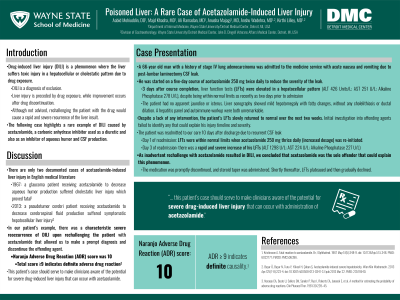Monday Poster Session
Category: Liver
P2529 - Poisoned Liver: A Rare Case of Acetazolamide-Induced Liver Injury
Monday, October 23, 2023
10:30 AM - 4:15 PM PT
Location: Exhibit Hall

Has Audio

Aabid M. Mohiuddin, DO
Detroit Medical Center/Wayne State University
Detroit, MI
Presenting Author(s)
Aabid Mohiuddin, DO1, Majd Khadra, MD1, Ali Ramadan, MD1, Anusha Majagi, MD1, Anshu Wadehra, MD2, Kirthi Lilley, MD3
1Detroit Medical Center/Wayne State University, Detroit, MI; 2Wayne State University, Detroit, MI; 3Wayne State University School of Medicine / Detroit Medical Center, Detroit, MI
Introduction: Drug-induced liver injury (DILI) is a phenomenon where the liver suffers toxic injury in a hepatocellular or cholestatic pattern due to drug exposure. DILI is a diagnosis of exclusion. The following case highlights a rare example of DILI caused by acetazolamide, a carbonic anhydrase inhibitor used as a diuretic and also to limit CSF production.
Case Description/Methods: A 66-year old man with a history of stage IV lung adenocarcinoma was admitted to the medicine service with acute nausea and vomiting due to post-lumbar laminectomy CSF leak. He was started on a five-day course of acetazolamide 250 mg twice daily to reduce the severity of the leak. Three days after course completion, his liver function tests (LFTs) were elevated in a hepatocellular pattern (ALT 426 Units/L; AST 251 U/L; Alk. Phos. 278 U/L) despite being within normal limits two days prior to admission. The patient had no apparent jaundice or icterus; liver sonography showed mild hepatomegaly with fatty changes, without any cholelithiasis or ductal dilation. A hepatitis panel and autoimmune workup were both unremarkable.
Despite a lack of any intervention, the patient’s LFTs returned to normal after two weeks. An initial investigation failed to identify a cause that could explain his injury timeline and severity.
The patient was readmitted to our care ten days after discharge due to recurrent CSF leak; acetazolamide 250 mg was re-initiated, now thrice daily. On day one of readmission, LFTs were within normal limits, however there was a rapid and severe increase of LFTs by day three (ALT 1298 U/L; AST 224 U/L; Alk. Phos. 227 U/L). As its inadvertent rechallenge resulted in DILI, we concluded that acetazolamide was the sole offender that could explain this phenomenon. We promptly discontinued the drug and administered a steroid taper; shortly thereafter, LFTs plateaued and then gradually declined.
Discussion: There are only two documented cases of acetazolamide-induced liver injury. In 1967, a glaucoma patient suffered fatal cholestatic injury; in 2013, a pseudotumor cerebri patient developed hepatocellular injury. In our patient’s example, there was a characteristic severe reoccurrence upon rechallenging the patient with acetazolamide that allowed us to make a prompt diagnosis and discontinue the offending agent. The Naranjo Adverse Drug Reaction Score was 10, implying definite causality. This patient’s case should serve to make clinicians aware of the potential of severe drug-induced liver injury that can occur with acetazolamide.
Disclosures:
Aabid Mohiuddin, DO1, Majd Khadra, MD1, Ali Ramadan, MD1, Anusha Majagi, MD1, Anshu Wadehra, MD2, Kirthi Lilley, MD3. P2529 - Poisoned Liver: A Rare Case of Acetazolamide-Induced Liver Injury, ACG 2023 Annual Scientific Meeting Abstracts. Vancouver, BC, Canada: American College of Gastroenterology.
1Detroit Medical Center/Wayne State University, Detroit, MI; 2Wayne State University, Detroit, MI; 3Wayne State University School of Medicine / Detroit Medical Center, Detroit, MI
Introduction: Drug-induced liver injury (DILI) is a phenomenon where the liver suffers toxic injury in a hepatocellular or cholestatic pattern due to drug exposure. DILI is a diagnosis of exclusion. The following case highlights a rare example of DILI caused by acetazolamide, a carbonic anhydrase inhibitor used as a diuretic and also to limit CSF production.
Case Description/Methods: A 66-year old man with a history of stage IV lung adenocarcinoma was admitted to the medicine service with acute nausea and vomiting due to post-lumbar laminectomy CSF leak. He was started on a five-day course of acetazolamide 250 mg twice daily to reduce the severity of the leak. Three days after course completion, his liver function tests (LFTs) were elevated in a hepatocellular pattern (ALT 426 Units/L; AST 251 U/L; Alk. Phos. 278 U/L) despite being within normal limits two days prior to admission. The patient had no apparent jaundice or icterus; liver sonography showed mild hepatomegaly with fatty changes, without any cholelithiasis or ductal dilation. A hepatitis panel and autoimmune workup were both unremarkable.
Despite a lack of any intervention, the patient’s LFTs returned to normal after two weeks. An initial investigation failed to identify a cause that could explain his injury timeline and severity.
The patient was readmitted to our care ten days after discharge due to recurrent CSF leak; acetazolamide 250 mg was re-initiated, now thrice daily. On day one of readmission, LFTs were within normal limits, however there was a rapid and severe increase of LFTs by day three (ALT 1298 U/L; AST 224 U/L; Alk. Phos. 227 U/L). As its inadvertent rechallenge resulted in DILI, we concluded that acetazolamide was the sole offender that could explain this phenomenon. We promptly discontinued the drug and administered a steroid taper; shortly thereafter, LFTs plateaued and then gradually declined.
Discussion: There are only two documented cases of acetazolamide-induced liver injury. In 1967, a glaucoma patient suffered fatal cholestatic injury; in 2013, a pseudotumor cerebri patient developed hepatocellular injury. In our patient’s example, there was a characteristic severe reoccurrence upon rechallenging the patient with acetazolamide that allowed us to make a prompt diagnosis and discontinue the offending agent. The Naranjo Adverse Drug Reaction Score was 10, implying definite causality. This patient’s case should serve to make clinicians aware of the potential of severe drug-induced liver injury that can occur with acetazolamide.
Disclosures:
Aabid Mohiuddin indicated no relevant financial relationships.
Majd Khadra indicated no relevant financial relationships.
Ali Ramadan indicated no relevant financial relationships.
Anusha Majagi indicated no relevant financial relationships.
Anshu Wadehra indicated no relevant financial relationships.
Kirthi Lilley indicated no relevant financial relationships.
Aabid Mohiuddin, DO1, Majd Khadra, MD1, Ali Ramadan, MD1, Anusha Majagi, MD1, Anshu Wadehra, MD2, Kirthi Lilley, MD3. P2529 - Poisoned Liver: A Rare Case of Acetazolamide-Induced Liver Injury, ACG 2023 Annual Scientific Meeting Abstracts. Vancouver, BC, Canada: American College of Gastroenterology.
